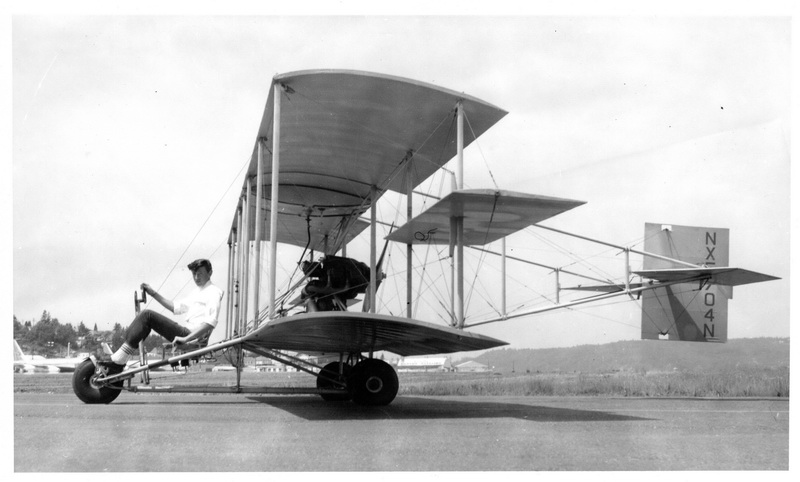But sometimes...Pete couldn't TAKE the photos himself. Like when he was flying the airplane in question, or wanted an "action shot" of him building the plane.
 Back when Pete
was building the Fly Baby, a young teenager named Dale Weir
lived within sight of his shop. Dale volunteered to help
build the plane. Once it was done, Pete put him to work as
the unofficial air-to-air photographer, putting him in the back
seat of a J-3 Cub. If you've seen a picture of the first
Fly Baby in flight, Dale probably took the picture.
Back when Pete
was building the Fly Baby, a young teenager named Dale Weir
lived within sight of his shop. Dale volunteered to help
build the plane. Once it was done, Pete put him to work as
the unofficial air-to-air photographer, putting him in the back
seat of a J-3 Cub. If you've seen a picture of the first
Fly Baby in flight, Dale probably took the picture.Dale didn't do too badly after, either. Once drafted into the Army (this WAS the '60s) he went to pilot training, graduating near the top of his class. After his hitch was over, Dale went to work for Columbia Helicopters Inc., working for 33 years pioneering a lot of civilian helicopter operations.
You don't recognize his name? You probably DO recognize the photo to the right. That's Dale as pilot-in-command of the muscle-bound helicopter towing a hover barge filled with 40 tons of equipment. The Helicopter Association International named him the 2006 Pilot of the Year, he's named on the National Air and Space Museum's Hall of Honor, and in 2019 the FAA gave him the Wright Brothers Master Pilot award.
The helicopter, by the way, is a Kawasaki model 107-II (license built version Boeing/Vertol 107-II).
The Photos
The majority of these photos were taken by Dale.
Otherwise, they were good Fly Baby shots taken by Pete or
others, and distributed by Pete.
Some of these photos are pretty well-known, others were new,
even to me. The NICE thing is that these are fresh scans
of good quality images. Generally a lot of the older
photos have been copied and copied over the years, and quality
goes to heck. These are brand-new scans of
first-generation photographs. I've cut the resolution
down to keep the page from taking forever to load, but the
originals have been scanned-in at 300-600 dpi.
This is STILL going to take a while to load...there's a lot
of pictures!
Table of Contents
Construction Photos
The First Fly Baby
Initial
Post-Rockford
Crash!
Air to Air
Biplane
Floats
Construction
Chronologically, this photo should be near the
end of this section. But this is a picture of Dale Weir
himself, sitting in the newly-completed fuselage of the
prototype Fly Baby. Dale did the varnishing of the
fuselage

Tail Feathers on display.

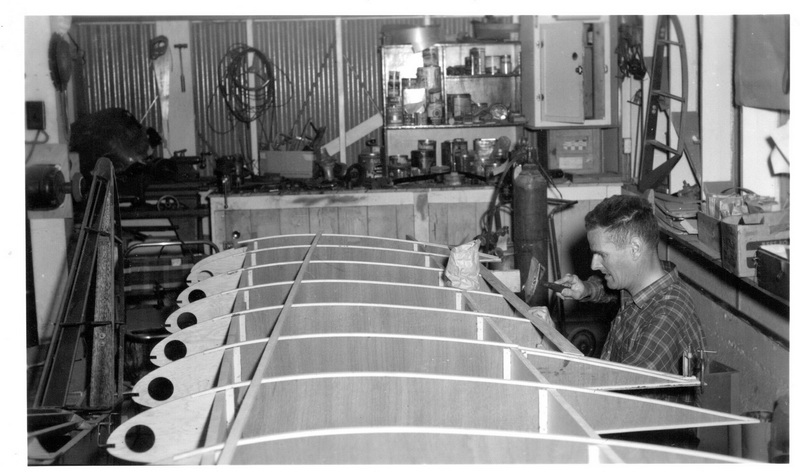
Pete stands on the completed wing. I'm sure he really, REALLY was careful stepping up there. Notice the white straps stabilizing each rib.

The main part of the fuselage going together.
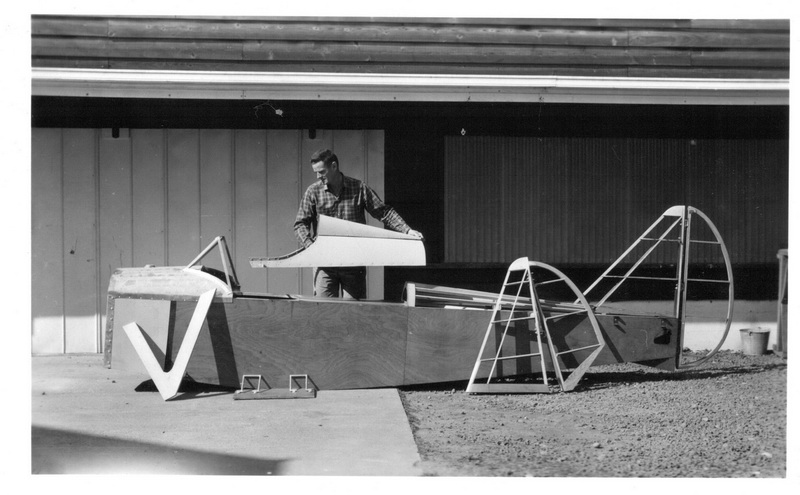
Here's the completed fuselage, with tail feathers and landing gear.
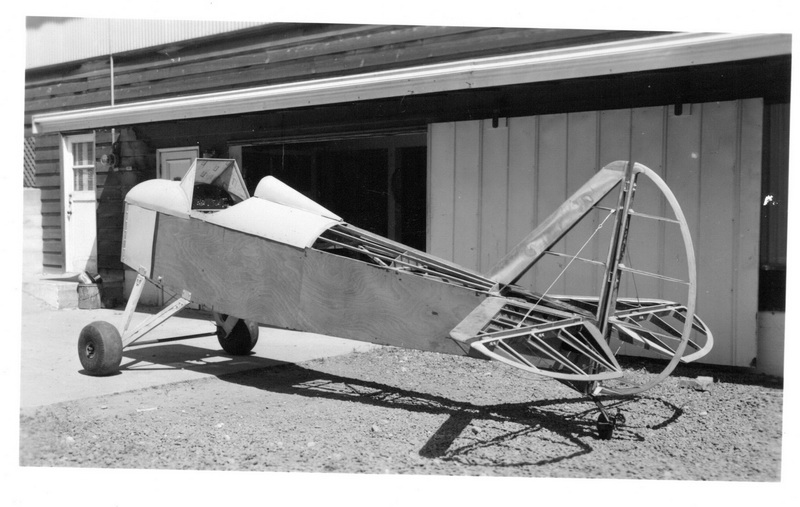
This is a shot of those who helped Pete in the build. Dale Weir in on the lower left, Ed Rudolph on the lower right. The other two are George and Dave Trepus.
%20Ed%20Rudolph%20(LR)_resize.jpg)
The First Fly Baby
Here's a great shot of the Fly Baby prototype.
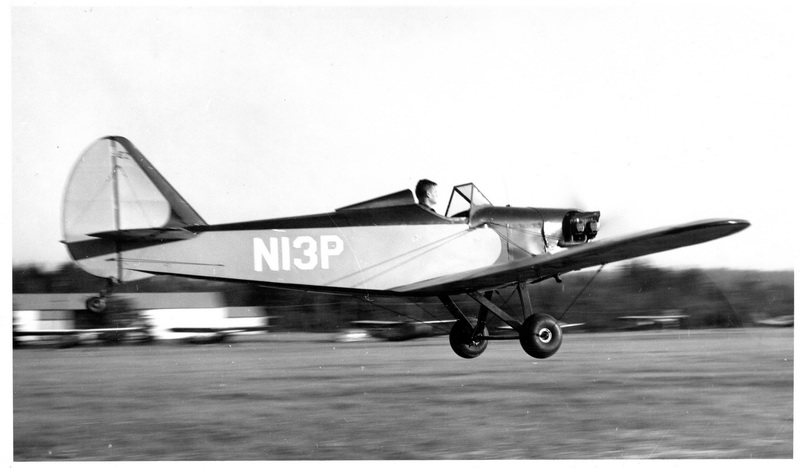
"Wait a minute," you say. "I thought the Fly Baby
prototype was registered as N500F?"
Well, there's a story behind that. The first prototype
was indeed licensed as N13P. But back then, the
registration had to be applied with 12" numbers. The FAA
(bless it's heart) came to the conclusion that short
registration numbers (like "N13P") should be reserved for
aircraft so small they couldn't take a conventional "long"
N-Number. So they contacted Pete, and told him to pick
another number...after the plane was already flying, of
course. As will be discussed below, Pete had a perfect
opportunity to apply the new N500F registration.
Initial Photos
One of the finds in Dale's collection was finding original
COLOR photos of N13P!
Why these colors? Because that's the colors the first
Boeing 707 was painted (the 367-80, or "Dash-80"). Pete,
a Boeing engineer, played tribute to the new jetliner.
Contrary to popular opinion, the yellow is not "Cub
Yellow". Pete used automotive enamel, and it was "School
Bus Yellow." The red was "Cordovan Brown."

You'll notice the cowling and the front turtledeck are silver
aluminum (unpainted). You see, Pete did a lot of taxi
testing before the first flight...and he ran the plane too low
on gas! The engine quit about twenty feet up, and he
bent the front metal and the axle landing. This
happened, basically, the DAY BEFORE the plane was to be
trailered to Rockford for the contest judging in 1960.
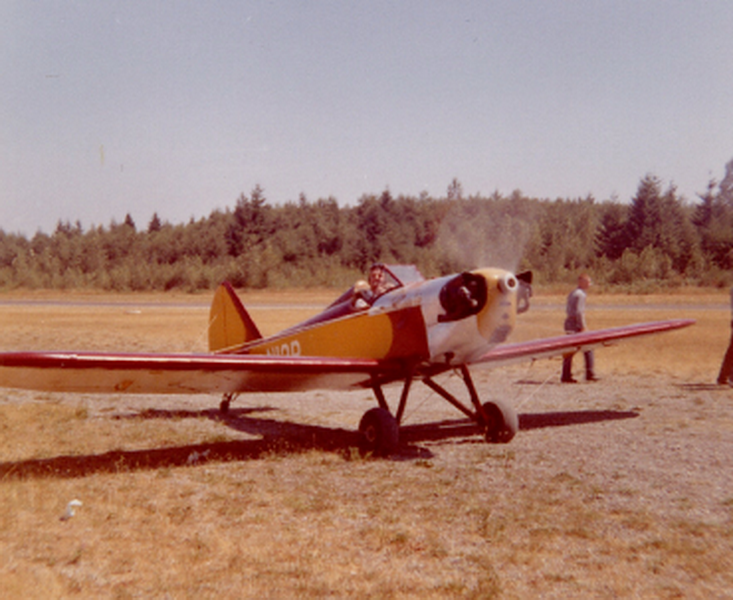
They patched it together and got it on the trailer. In this picture, you'll see the landing gear cross-braces are in the "X" form. This apparently contributed to the bending of the axle, and was changed later.
As it was, they didn't have the required 25 hours on the airplane for the contest...but there was only one other contestant at Rockford in 1960, and HE didn't have the required time, either. So the contest was postponed for two years.
There's only one apparent photo of N13P at Rockford...appears to be a wing-folding demonstration.
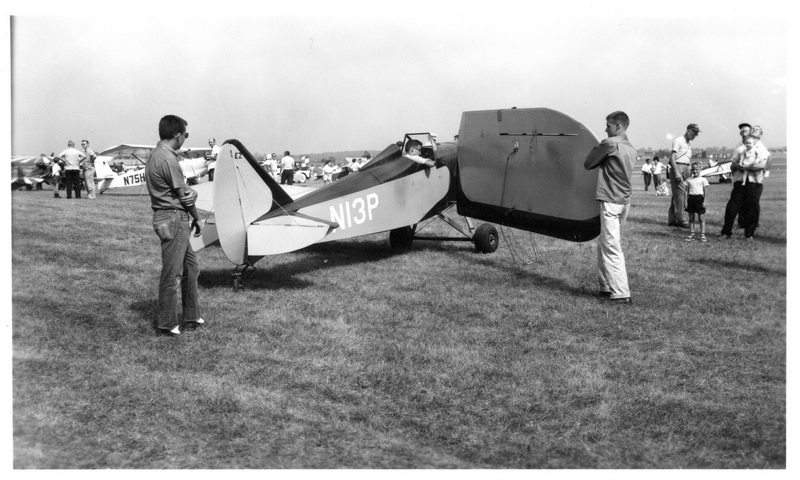
Post-Rockford Photos.
Pete got the airplane back home, fixed the little things, and
had Dale shoot a LOT of in-flight pictures....
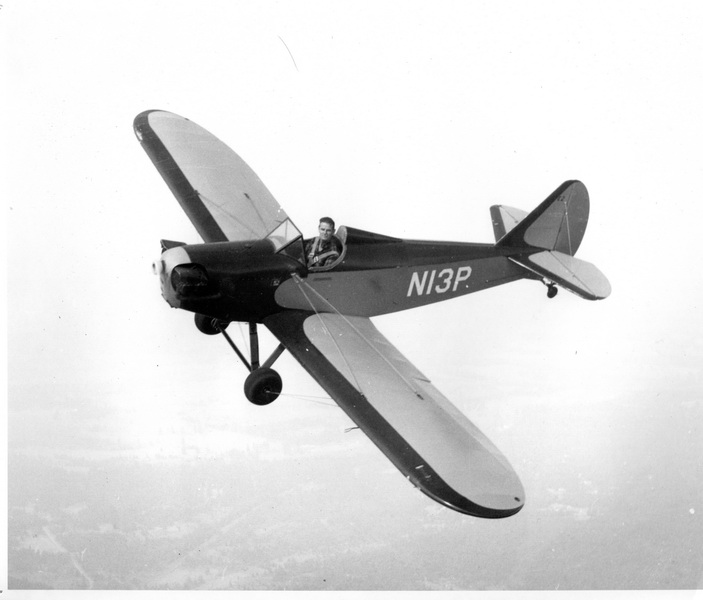
See the light-colored nose bowl on the cowling? This was
yellow, and came from one of Hobie Sorrell's biplanes.
It makes identification of N13P easy, even when the N-Number
isn't visible.
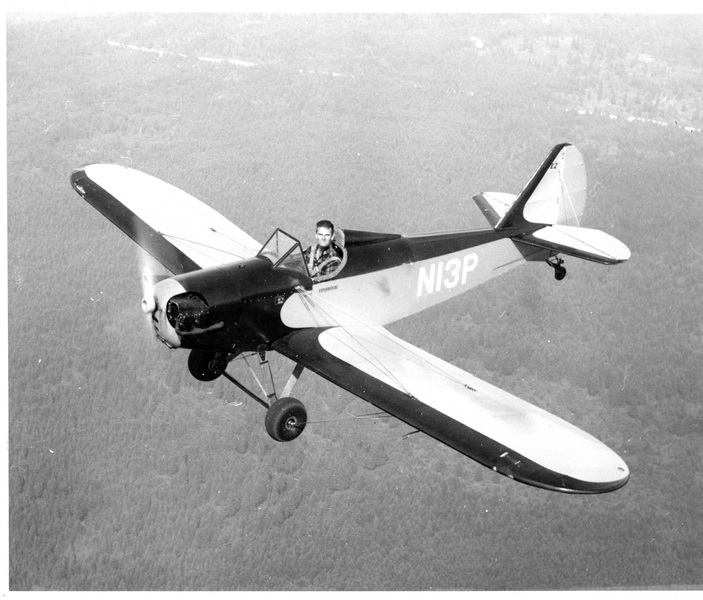
Does something seem missing? The "Fly Baby" logo was
never added to N13P.
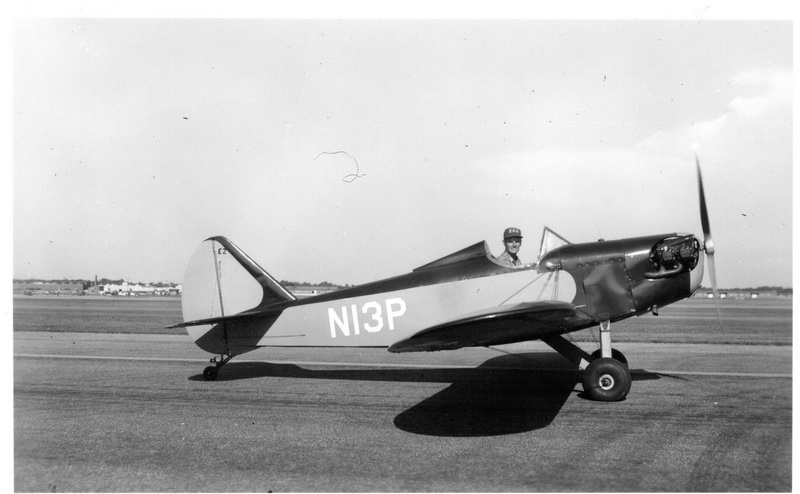
Also, note the "E2" label on the tail. That was applied
for Rockford 1960, denoting that it was the second entrant to
the design contest.
Crash!
Three months prior to the judging at Rockford 1962...the
below happened. The pilot ran out of fuel.
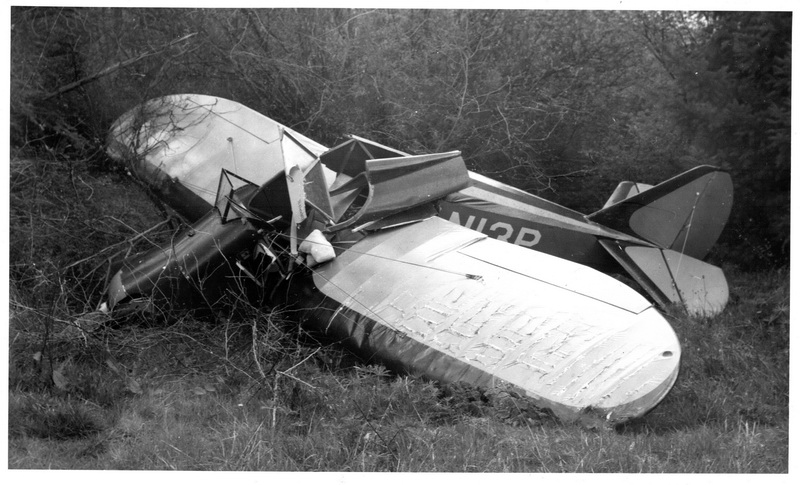
No one was hurt...but it seemed Pete's contest dreams were
crushed.
The above picture is pretty common, but Dale Weir's
collection included this great second view of the wreckage:
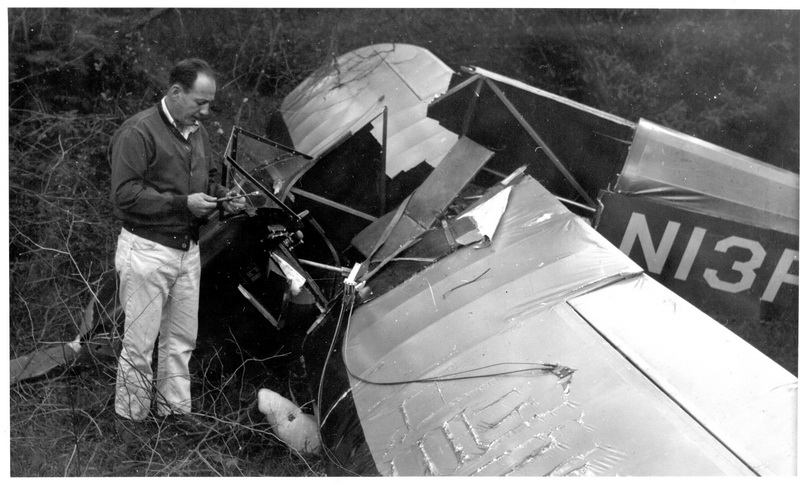
The caption on the back of the photo identifies the man as
Joe Roskie. Who was he? First guess, that he had
been the pilot, doesn't seem borne out by the lack of any
scrapes on his face.
I did find an obit for a Joe Roskie in 2002; the age checks
out, the fact that he was a pilot, and the fact that, at one
time, he'd worked for Boeing. This would tie into him
being a friend of Pete's, and helping to remove the airplane
from the woods and take it back to Pete's shop. Notice
he seems to have a wrench in his hand...
What happened next? In short, Pete built a new
fuselage, and had the airplane flying again by the first of
July, one month before the contest.
Rather than repeat myself, let me refer you to my summary, "Pretender
to the Throne?" And yes, the FAA (and EAA) did
deem the work as being a repair, not a brand-new
airplane. And Pete took the opportunity to paint the
FAA-mandated new registration number on the fuselage.
N500F
The new N500F was ready on the first of July, and this
picture was taken at Enumclaw airport (southeast of Seattle)
early in that month.
How do we know it's early? Because the "Fly Baby" logo
has yet to be added to the forward fuselage, and all the
picture at Oshkosh show it.
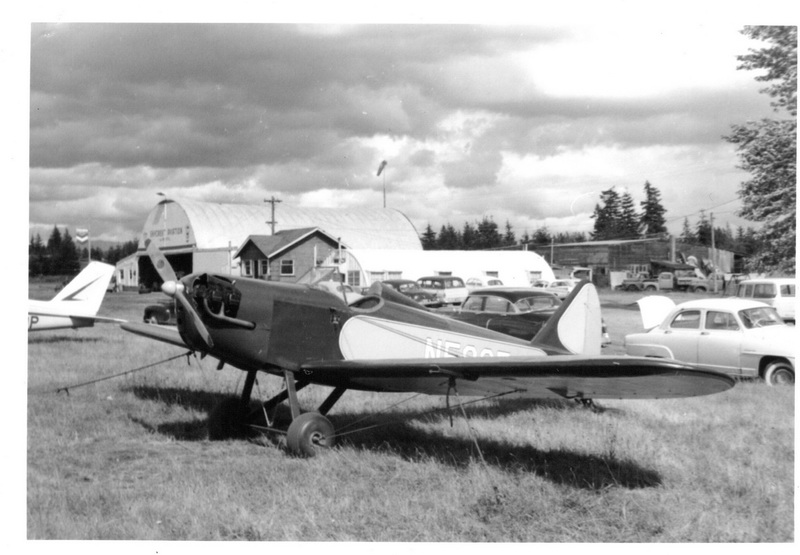
Note how the landing-gear brace wires are now in a "V" shape, rather than the "X" of N13P.
Here's another shot from before the 1962 contest...again, "Fly Baby" had yet to be painted on the nose. This was taken at old Auburn Airport, outside Auburn Washington. There's a casino there, now.
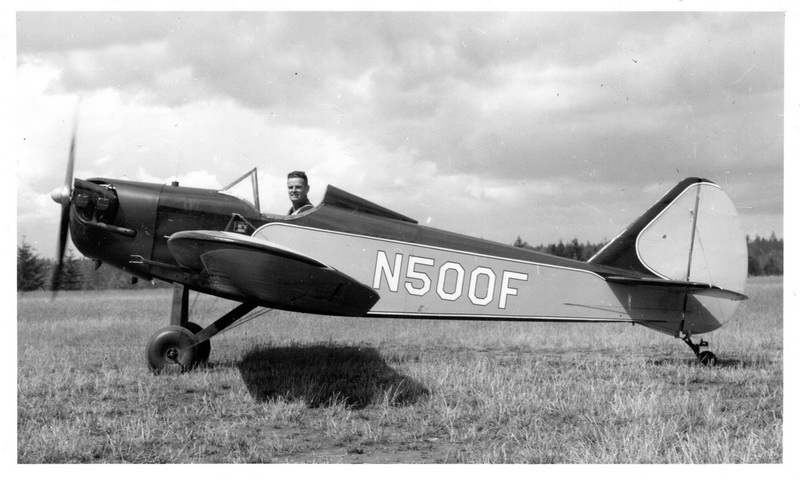
N500F had "cheat stripes" added to the paint job...thin white and black lines across the interface between the red and yellow (both standard aircraft dopes, now).
This shot shows the "Fly Baby" logo. It was also taken at the old Auburn Airport.

This picture is from Rockford 1964, not 1962 when the contest was settled. But it shows Dale Weir handling the airplane.
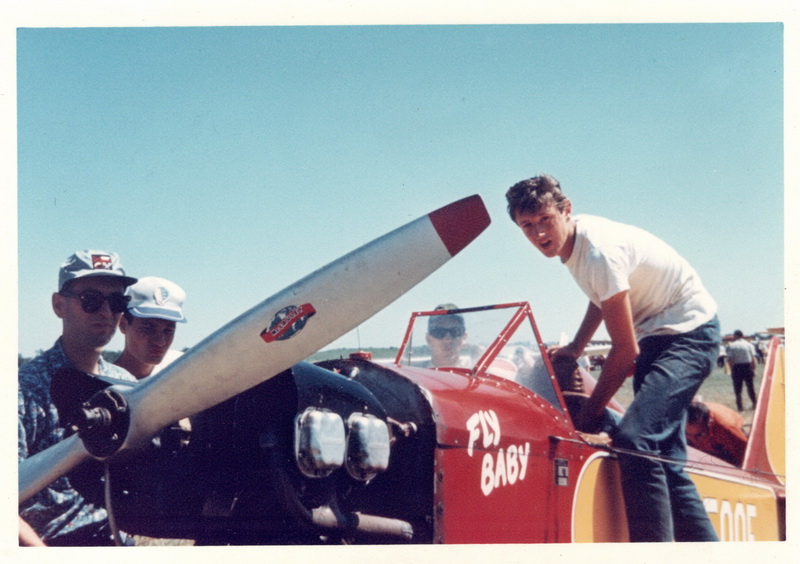
Air to Air
Now we get into Dale's main territory. Again, Pete couldn't take these shots himself, so he plopped Dale Weir into the back seat of a Cub and gave him his (very expensive!) camera.There's something you'll notice in air-to-air pictures of the Fly Baby. Half the time, Pete doesn't wear a flying helmet!
Now...it RARELY gets so hot in the Seattle area that you can omit the head warmer. Personally, I think Pete just liked to be identifiable, and he certainly is, in photos where he leaves the helmet off. Here's a good example.

See the N13P air-to-air for other examples of Pete flying with a bare head.
In some photos, he's wearing a distinctive white flying helmet. At first, I attributed it to several good shots being taken on a single flight. Then I noticed some of the white-helmet shot are in the Fly Baby without the "belly bomb."
Oh well.
Here's some great air-to-air shots. By the way, in westerns of the era, the good guy always wore a white hat....
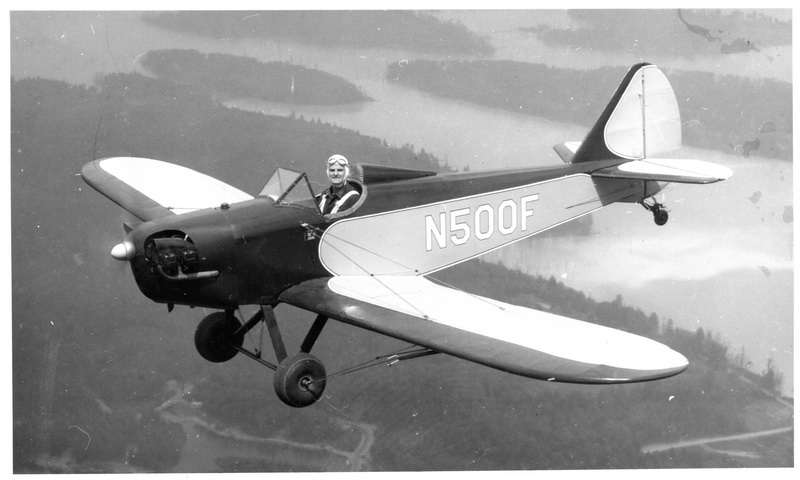

"Look ma, no hands!" Pilots often get their picture taken with the hands off the control as a demonstration of aircraft stability.


This is the most famous photo of N500F, taken by Dale Weir, with Washington State's Mount Rainier in the background. White helmet with belly bomb.

In 2023, Dale's picture was used as the inspiration for a mural at Auburn Airport:

Artist Myron Curry moved the Fly Baby a bit to center it on the mountain, but otherwise it's Dale's photo. The "Roscoe" patch, designed by Pat Moriarty, was also added.
Biplane
The Fly Baby is one of the few airplanes that can be flown as
both a monoplane and a biplane. The two big monoplane
wings are removed, and four new wing panels and a center
section are added. Note helmetless Pete, again.
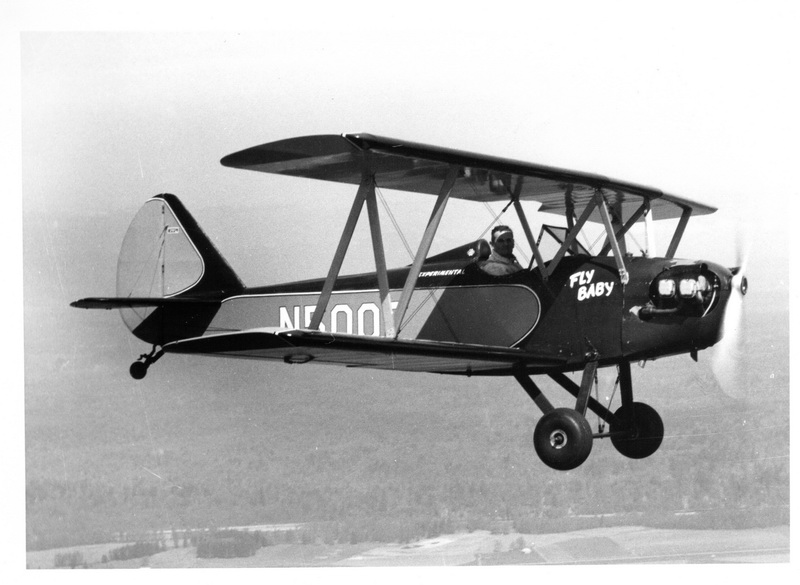
One of the neat things in Dale's collection was several color
photos of N500F as a biplane. He's wearing a helmet (not
the white one) and a coat for these. Must have been
cool....

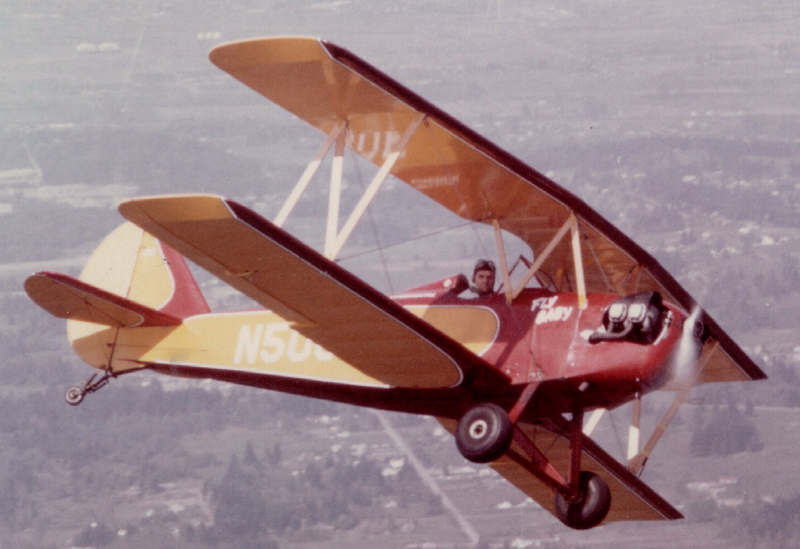
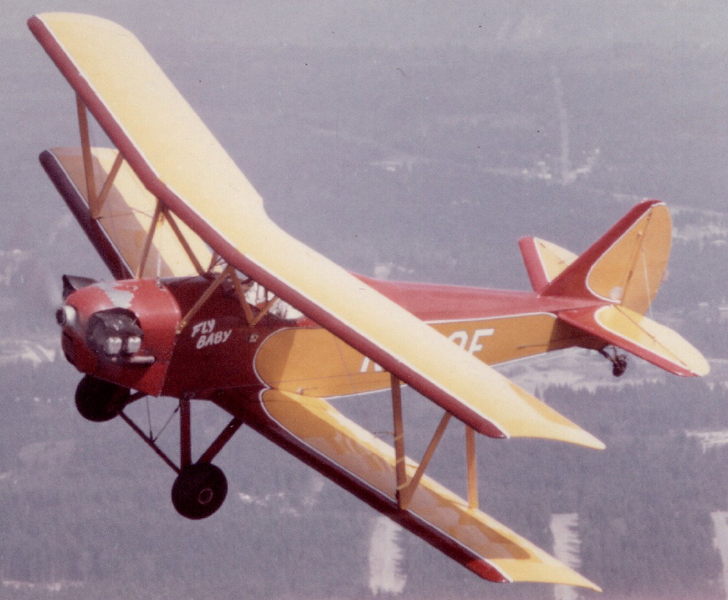
Floats

Pete's attempt to fit floats on the Fly Baby ended up with
some classic photos. The first time it taxied down the
seaplane ramp, the Fly Baby did a forward somersault into the
water. In classic Pete fashion, he quickly surfaced and
yelled, "Get a camera! Get a camera!"
Dale was there, with the camera....
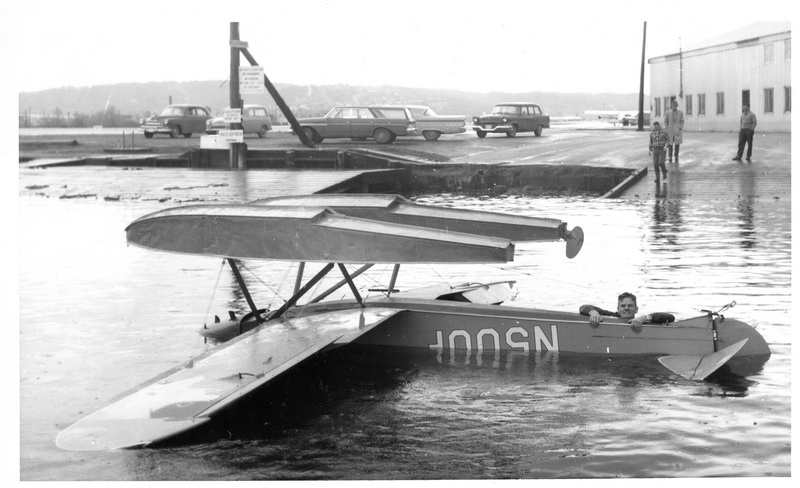
This next photo is pretty neat. It shows N500F out of
the water, with the engine running. ONLY ONE HOUR after
it was dragged out of the water....

The problem was traced to the floats being set too far
aft...they had enough buoyancy, but the center of floatation
was too far back. This is the classic picture of Pete
flying N500F on floats. Again, no helmet.
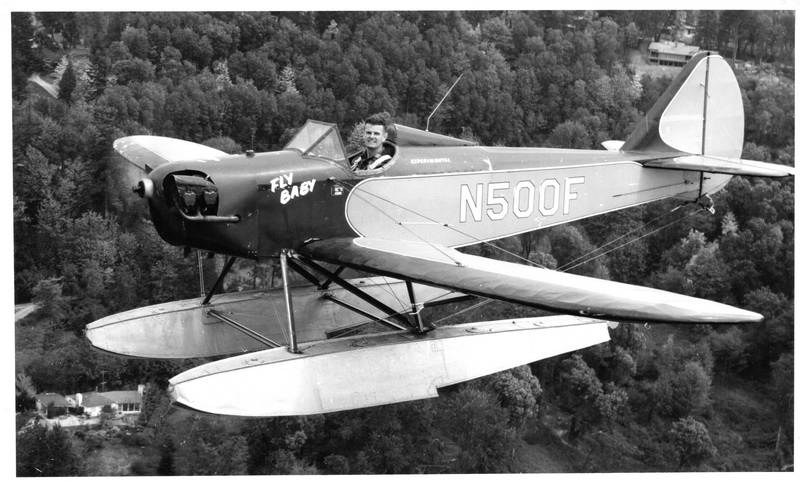
The above picture is used in a lot of places. But Dale had this photo in his collection, and I frankly like it better. Probably taken on the same flight.

Finally, about a year later, another pilot crashed the floatplane and wiped the floats off. The airplane was recovered and repaired, but never flew on floats again.
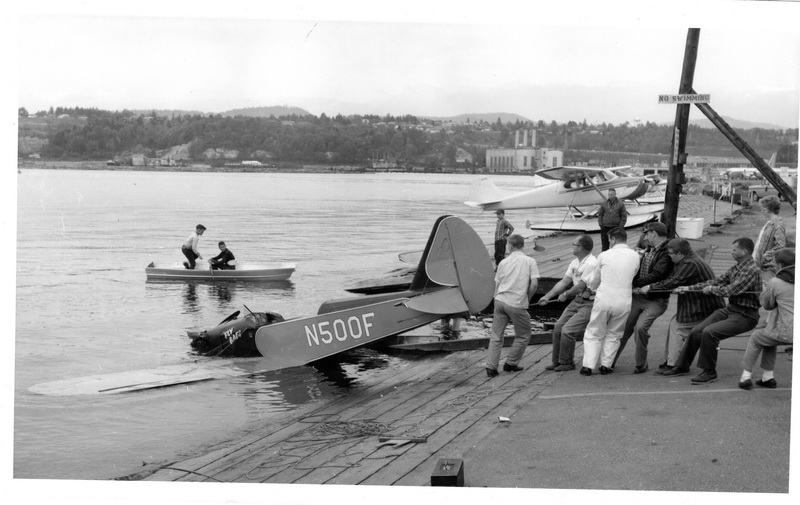
Miscellaneous Photos
Here's a few more from Dale's collection. Here's N13P
hooked up as a trailer to Pete's old Ford Station Wagon.
It had a trailer license, and taillights mounted in the wing
roots to make it legal.
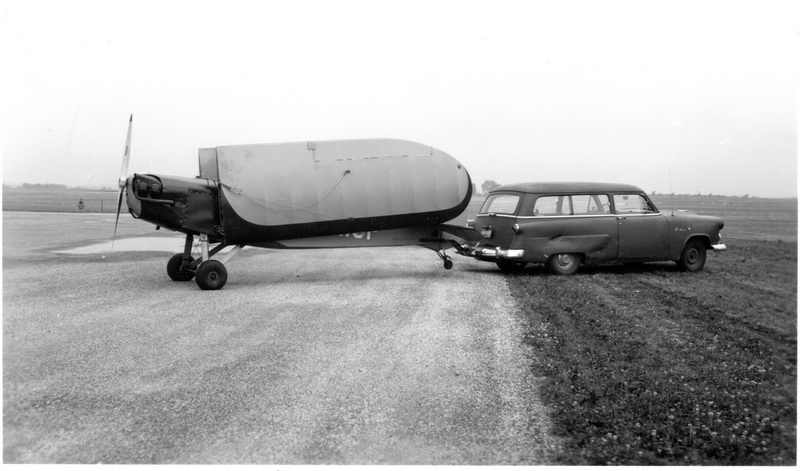
Legal, maybe, but this is no way to haul and airplane over any
sort of distance. When he took N500F to Rockford in both
1960 and 1962, he had a trailer. Dale Weir took this
photo outside his house for the 1962 trip.

Not the best-quality photo, but it shows N500F flying with the
first customer-built Meyers Little Toot.
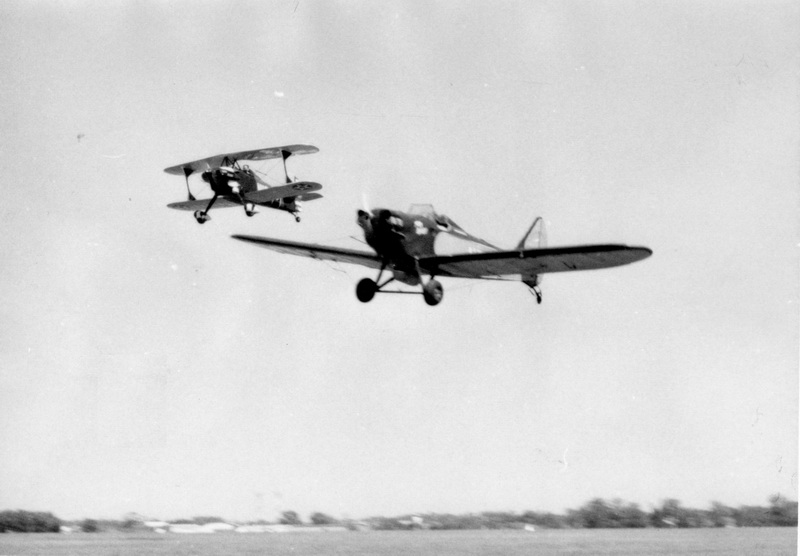
When Pete was at Rockford for the contest in 1962, he took
photos of some of his contest competitors. Here's the
Tefft Contestor:
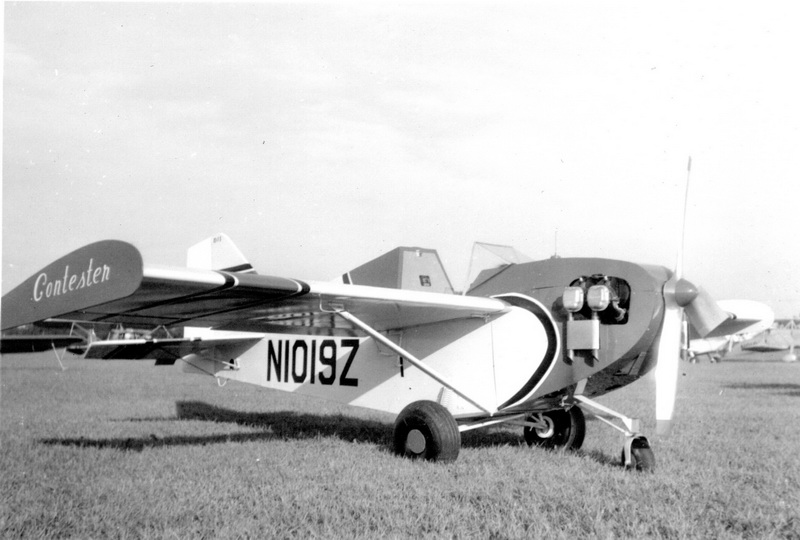
And, probably the closest to the Fly Baby, the Spezio
Tuholer.

Finally, let's turn to one of the most famous photos of Pete
Bowers... with a Curtiss replica, in "formation" with the
Boeing 707 prototype (the Dash 80).

and...here's young Dale Weir again. Sitting in Pete's
Curtiss....
